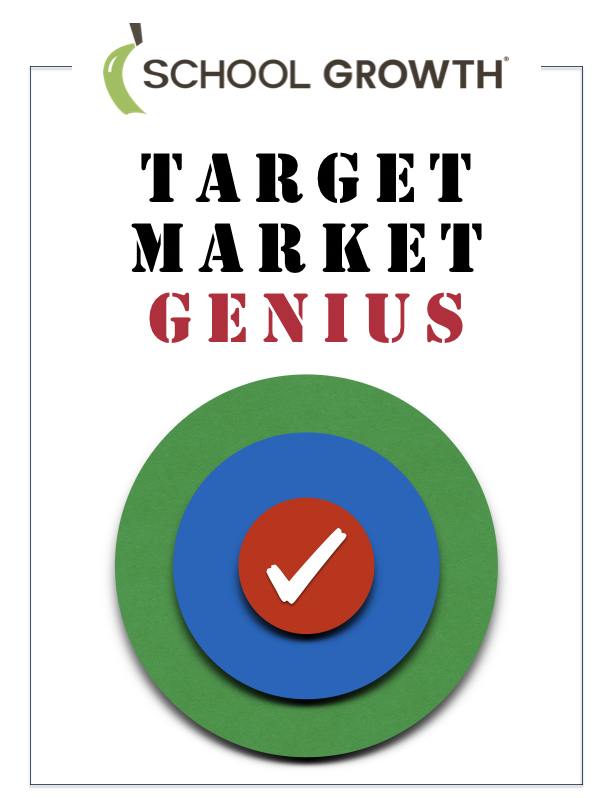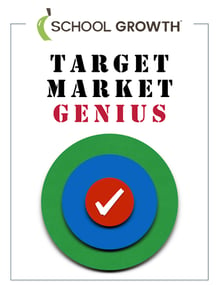
How Well Do You Know Your Target Market?
 What do you know about your target market of families? Everyone has a confirmation bias that clouds objectivity and the ability to genuinely listen. Cognitive bias isn't new, but it can be a huge barrier to your ability to innovate and grow enrollment in this emerging economy.
What do you know about your target market of families? Everyone has a confirmation bias that clouds objectivity and the ability to genuinely listen. Cognitive bias isn't new, but it can be a huge barrier to your ability to innovate and grow enrollment in this emerging economy.
(See Special Offer Enrollment Growth Plan PowerPack 2020 to advance your target market genius and admissions results)
School growth strategy requires a deep understanding of your target market and how to create distinctively superior value for those decision makers. Determining your primary family profile is a make-or-break decision because it enables you to focus your limited resources to meet and exceed their specific needs.
A granular approach to understanding your target market provides important advantages as competition expands. The educational services of your school may appeal to a wide variety of families with different needs and goals, but a broad marketing and sales approach is less focused and generally more expensive.
You can't be all things to all people!
So let's consider a few key questions to assess your target market genius.
Who is the decision maker?
As someone who is directly or indirectly responsible for enrollment, you probably have a buyer persona that clarifies your ideal family and the key decision maker(s). Data attributes you may have included are:
Career — Employer, industry, professional expertise.
Resources — Access to internal or external financial support.
Educational History — School(s) previously attended, allegiances, characteristics, key features, results.
Goals — Short- and long-term outcomes that may motivate the school choice.
Student Information Systems have started adding CRM features to help schools more effectively track this data. In a recent conversation with the leadership at FACTS, for example, they shared with us about some exciting new enrollment funnel management capabilities.
Parents are the primary target of most K-12 marketing but the students play a very influential role starting in about 4th grade and that grows larger as they get older. The decision maker isn't necessarily the person who first reaches out to you.
What do they want?
Multiple studies show that there is variation in family goals and preferences when choosing a school. In our review of the data available from NAIS, EMA, and other associations, along with our own focus groups and survey data from strategic planning engagements, two priorities remain constantly at the top:
- High quality faculty with strong content knowledge combined with considerable capacity and desire to build deep relationships.
- A trustworthy peer group in which community and connection can be found.
You definitely want to focus on what they're buying--not just the talking points in which you've fallen in love.
The Friedman Foundation for Educational Choice conducted a survey of families that participated in the Georgia GOAL scholarship program. They found that about half of the families prioritized:
- Better discipline
- Better learning environment
Smaller class sizes - Improved student safety
Only 10% identified higher standardized-test scores as top priority in their school choice. (Additional research is available from EdChoice)
Does everyone on your leadership (administration and board) understand and agree on what your target market of families deeply wants? How does your school uniquely provide what they want? Do you consistently deliver on your brand promise and value proposition?
What do they fear?
Choosing a school is a high stakes decision, and people tend to be more motivated to avoid pain than they are in achieving success. When it comes to their student's education, what do the parents in your target market express as their most common concerns, headaches, or fears? What may cause hesitation or dread for the students?
Answering these question requires data along with conversations with families and among your leadership. You may want to use an empathy map to help you challenge your assumptions and create alignment.
If you can design your education program to genuinely solve their biggest and real fears, you're story will be far more compelling.
What is your plan for growing enrollment?
As you've heard from us many times, a data-driven Enrollment Growth Plan will give you both a competitive advantage in the market and greater credibility with stakeholders. Data from student information system, inquiry tracking, surveys, and focus groups can be combined to increase the accuracy of leadership decisions and accelerate your ability to respond to market opportunities.

.png?width=1000&height=199&name=SG-Logo3-Transparent-1000x199px%20(1).png)




